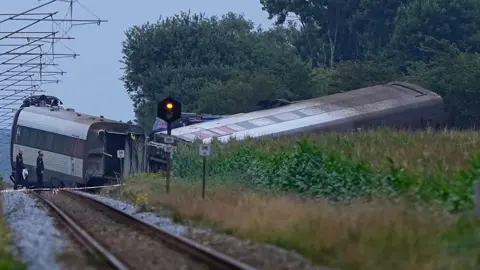In a tragic incident in southern Denmark, a train collided with a slurry tanker, causing the train to derail and resulting in at least one fatality and several injuries. The collision occurred on August 15, 2025, between the towns of Tinglev and Kliplev in southern Jutland, highlighting the dangers and risks associated with level crossings in railway transport. Authorities and emergency services responded quickly to the accident site, as detailed by local police who reported the event and initiated investigations into the circumstances surrounding the crash.
The collision happened during a time when the train was approaching a level crossing, a point where trains traditionally intersect with roads at ground level. Local news outlet TV2 confirmed the report, indicating that this incident involved a slurry tanker being struck by the train. Following the accident, helicopters were dispatched to the scene to assist with emergency services and transport the injured to medical facilities. The national rail operator, DSB, announced the suspension of train services between Tinglev and Sønderborg, an area near the border with Germany, which impacted numerous passengers and rail networks.
Images from the site painted a stark picture of the aftermath of the crash. Photographs revealed one of the train carriages resting on its side, and passengers were spotted gathered around the train tracks, witnesses to the chaos and confusion that ensued. Among the 95 passengers who were on board the train were students from a nearby school in Sønderborg, which heightens the tragedy of the event. Two individuals critically injured in the incident were transported away from the site by helicopter, illustrating the severity of the situation.
The national rail agency, Banedanmark, corroborated the details about the collision happening at a railway crossing, providing insights into the operational and safety measures that could come under scrutiny as investigations continue. As safety agencies assess the injuries and evaluate the condition of all involved, the incident raises questions about the safety protocols in place at railway crossings, as well as the infrastructure supporting rail transport in Denmark.
In the aftermath, local police, alongside relevant safety authorities, have begun investigative work to determine the specifics of how the accident took place, aiming to elucidate whether there were any failures in signaling or other safety mechanisms at the crossing. Moreover, the evidence surrounding visibility at the level crossing and potential contributing factors to the accident—a critical angle of any railway collision investigation—will be a focus moving forward.
This disaster underscores a broader concern regarding railway safety within Denmark and worldwide. Accidents at level crossings can often result in catastrophic outcomes, as trains typically cannot stop suddenly due to their size and speed. This incident may provoke discussions about the need for improved safety measures, enhanced signaling systems, or re-evaluation of existing crossings where such accidents have occurred in the past.
Overall, the collisions serve as a sobering reminder of the critical intersection between road and rail safety. Efforts will likely continue to be made to implement better safety protocols to minimize the risk of similar tragedies occurring in the future, ensuring both rail users and road vehicles can coexist more safely. Ensuring suitable measures and resources are in place to protect the lives of passengers, especially considering the presence of students from nearby social establishments, will be paramount in the wake of this incident. As investigations conclude and more information emerges, updates will be essential for the affected communities and rail transport authorities in Denmark.












